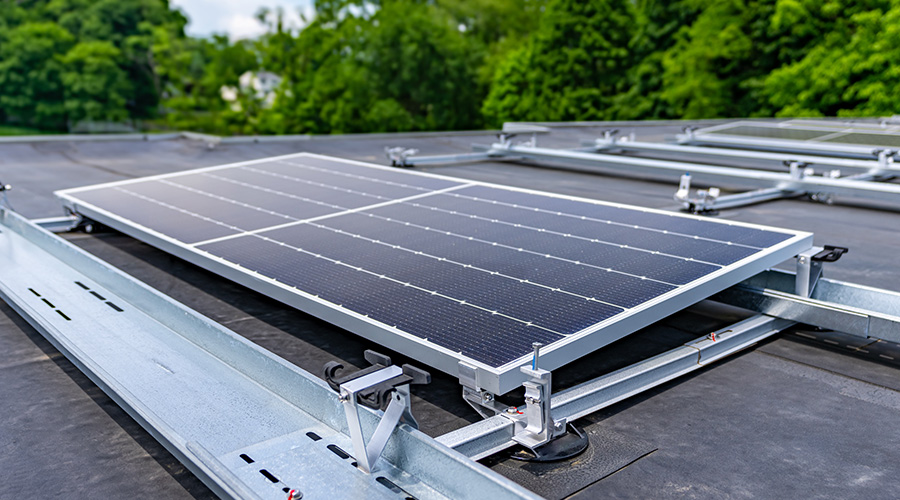Sustainable Roofing Strategies

Choosing the right roofing materials can make a significant difference in energy efficiency
“Out of sight, out of mind” often rings true when it comes to roofs. Rarely do facility managers give roofs a second thought until significant problems arise, by which time the damage — and the costs — can be considerable.
However, the ideal time to focus on institutional and commercial roofs is right from the start, during the concept and design stages. Select sustainable roof options offering substantial energy savings, then safeguard the investment with regular maintenance inspections, life-extending upkeep, and timely replacements.
“Facility managers need to look at their roofs differently,” says John D’Annunzio, president of Paragon Roofing Technology, a building exterior consulting and testing firm. “The roof is the largest exterior component of a building and should receive as much attention as other components in a building.”
Roofing plays a pivotal role in protecting the structure but also in energy efficiency. As businesses increasingly prioritize environmental responsibility and operational cost savings, choosing the right roofing materials and strategies can make a significant difference.
Energy-efficient roofing options transforming today’s commercial buildings include cool roofs, photovoltaic solar panels, green roofs, metal roofs, and ethylene propylene diene monomer (EPDM) roofing.
Cool roofs
Cool roofs are capturing the attention of energy conscious companies across the globe. These roofs are engineered to reflect more sunlight and absorb less heat than traditional roofs, says Audrey McGarrell, project manager of the Cool Roof Rating Council (CRRC).
CRRC, which is nonprofit, impartial, and independent, runs programs that rate roofing and exterior wall products, conducts technical research to ensure data accuracy, and provides education and outreach about cool roofs. The organization evaluates roofing materials for their ability to reflect solar energy (solar reflectance) and their ability to emit heat that is absorbed (thermal emittance) to determine their efficiency in returning heat into the atmosphere instead of transferring it into the building, McGarrell says.
Though these ratings reflect how the roofing materials perform, the return on investment may differ in different regions of the country, says McGarrell. ASHRAE rates and lists climate zones as one through seven and divides each zone into A and B, with some zones having a C category.
“As a rule of thumb, climate zones 1A through 4B are where you will see the most significant energy savings with a cool roof,” she says. “These zones are in the warmer half of the country, where studies have shown that cooling energy savings in the summer will outweigh any heat penalty in the winter.”
Even with negligible energy savings in northern climates, McGarrell says cool roofs still provide advantages in the northern states.
“Cool roofs help mitigate the urban heat island effect, which can occur when cities are hotter than their more rural surroundings,” she says. “As we see more heat waves in areas where people might not have a lot of air conditioning, cool roofs are a fantastic way to improve resilience to heat and reduce the urban heat island effect.”
Facility managers can calculate the savings they can expect on their cool roofs using the Oak Ridge National Laboratory calculator for low-slope or flat commercial roofs.
Photovoltaic solar panels
Solar roofing systems harness the power of solar panels to generate electricity, which can either be used to power the building or sold back to the energy grid. With this roofing system, it’s possible to decrease energy costs and carbon emissions.
“Installing solar panels on your roof can save energy,” says Serena Varner, project manager for FEA, a company that specializes in facility maintenance and repair. “Solar panels will produce energy by absorbing the sunlight, which can lower electricity bills. But they also are another way to absorb solar energy and deflect it away from the interior of the building to keep temperatures lower inside.”
Commercial solar panel installations can cost anywhere from $100,000 for a small business to $1 million or more for larger buildings, according to an article on Forbes Home. Additionally, research indicates solar panels can lower energy bills, provide tax benefits, raise property values, and pay for themselves in three to seven years.
For the best return on investment, D’Annunzio recommends applying a reflective coating on the roof before solar panel installation. By reflecting solar rays, the coating helps the panels generate additional energy from the sun.
However, not every building is a good fit for solar power, says Varner.
“You need to consider the structural loads solar panels put on a building,” she says. “Some buildings have not been constructed to handle that load.”
The panels also must attach to the roof somehow, she adds.
“Every new penetration into a roofing system opens up the potential area for leaks,” she says. “A ballasted system can be used to install panels without penetrating the roof membrane, but it may make the membrane less accessible.”
To ensure optimal results, Varner recommends assessing the roof membrane’s condition before installing solar panels and even applying a new membrane beforehand.
“You want to have a newer system so that you don’t have a ton of repairs and maintenance soon after the panels are installed,” she says. “Because the roofing membrane will not be easily accessible once you put panels on it.”
After installation, D’Annunzio advises examining the roof for damage.
“Even if the roof itself wasn’t penetrated, there may be some damage from the work that was done, the foot traffic or dropped materials on the roof,” he says.
Ronnie Wendt is a freelance writer based in Minocqua, Wisconsin.
Related Topics:
The post "Sustainable Roofing Strategies" appeared first on Building Operating & Management

